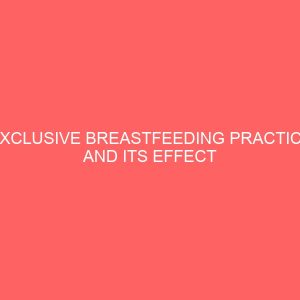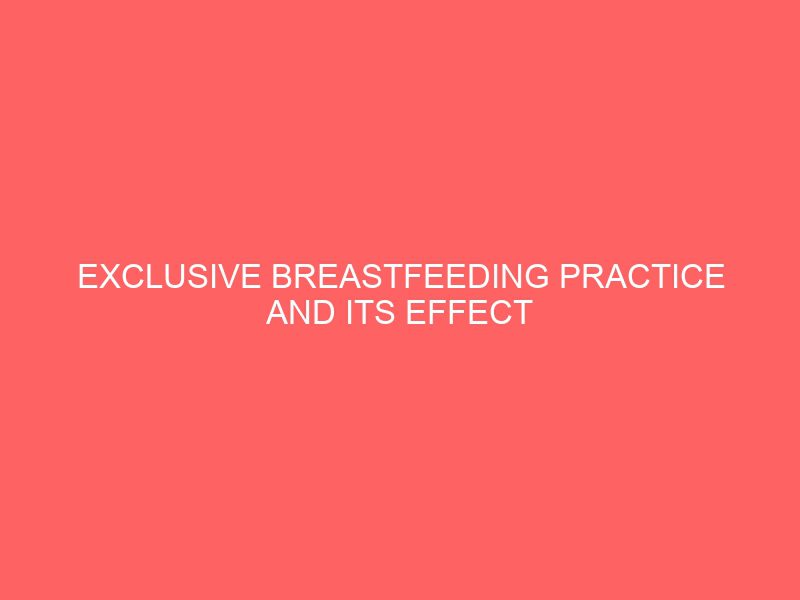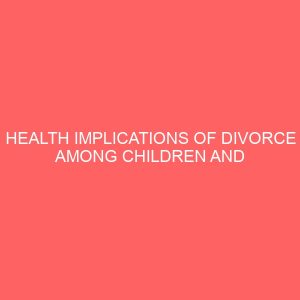EXCLUSIVE BREASTFEEDING PRACTICE AND ITS EFFECT ON THE PHYSICAL APPEARANCE OF THREE TO SIX MONTHS BABIES (A CASESTUDY OF SELECTED FAMILIES IN SURULERE LOCAL GOVERNMENT AREA OF LAGOS STATE)
CHAPTER ONE
1.0 Background to the Study
Breast milk according to Olusegun (2006) has been described as the best natural food and drink created by God for newborn babies. According to him, newborn babies do not need any form of other food or drink, not even water or fruit juice because the breast milk contains enough water and fruit juice for the body. In this regard, UNICEF (2000) recommends that no additional food or fluid is necessary, as it could be a means of introducing harmful bacteria into a newborn baby?s system. However, breastfeeding is all about feeding an infant or newborn baby with breast milk directly from human breast rather than from a baby bottle or other container. This can be exclusive or inexclusive. According to UNICEF (1990), when breastfeeding is exclusive, breast milk alone is given to babies for the first six months of life and the introduction of complementary foods thereafter vice versa.
Exclusive breastfeeding practice by nursing mothers has been noted to have a lot of influence on the physical appearance, growth and development of infants (WHO/UNICEF, 2007). However, it is quite unfortunate that a reasonable number of nursing mothers are not aware of this paramount importance of exclusive breastfeeding practice. Some of them that are aware of it do not practice it due to factors ranging from socio-economic to environmental. Relatively, the WHO/UNICEF?s study in 2007 showed that exclusive breastfeeding of babies during the first six months of life was significant in cushioning the rate of child mortality by an estimated 20% in different parts of Africa. The study also revealed that 1.3 million additional children?s lives could be saved every year if exclusive breastfeeding rate could be raised above 90% level. In addition, Wilson (1998) pointed out that initiation of exclusive breastfeeding in the first hour of life reduces the rate of neonatal mortality by nearly four times.
Besides, infants and children under five years of age have been noted to be the most vulnerable to malnutrition and preventable diseases. In this part of the world, especially in Nigeria as noted by Olusegun (2006), mortality rate has remained high as a result of poor exclusive breast feeding practice. In 1990, it was reported that the recorded deaths of more than one million infants which were mostly caused by feeding those infants with breast milk substitutes could have been prevented via exclusive breastfeeding practice (UNICEF, 1995). Hence, exclusive breastfeeding according to UNICEF (1994) provides complete hygienic nutrition for newborn babies.
Nevertheless, Gilhan et al (2001) and Arenz et al (2004) further revealed that there is a link between breastfeeding and non-communicable disease. Also, Pettit et al (1997) and Young (2002) further revealed in their study that the prevention of chronic diseases in later life could be guaranteed through exclusive breastfeeding in the first six months of life. It is against the above numerous importance of exclusive breastfeeding and its diverse impact on the life of newborn babies that inspired the carrying out of this study to examine the extent to which exclusive breastfeeding could influence the physical appearance of three to six months old babies.
1.1 Statement of Problem
The entire business of this study bothers on determining the extent to which exclusive breastfeeding practice could affect the physical appearance of three to six months babies. This is predicated on the findings of Olusegun (2006) and Wilson (1998) which respectively revealed a positive influence of exclusive breastfeeding practice on the physical appearance of newborn babies. However, this study attempts to authenticate the truism of the above findings.
1.2 Purpose of the study
The aim of this study includes:
1. To examine the effect of exclusive breastfeeding practice on the health of babies between the ages of three to six months.
2. To assess the effect of exclusive breastfeeding practice on the size of babies between the ages of three to six months.
3. To determine the extent to which exclusive breastfeeding practice could affect the physical development of babies between the ages of three to six months.
1.3 Research Questions
The following research questions were raised to guide the study.
1. Does exclusive breastfeeding practice affect the health of babies between the ages of three to six months?
2. Is the size of babies between the ages of three to six months affected by exclusive breastfeeding practice?
3. To what extent is the physical development of babies between the ages of three to six months affected by exclusive breastfeeding practice?
1.4 Research Hypothes
The following hypotheses were posited for testing during the study.
1. The health of babies between the ages of three to six months is significantly affected by exclusive breastfeeding practice.
2. The size of babies between the ages of three to six months is significantly affected by exclusive breastfeeding practice.
3. The physical development of babies between the ages of three to six months is significantly affected by exclusive breastfeeding practice.
1.5 Significance of the Study
The study of exclusive breastfeeding practice and its effect on the physical appearance of three to six months babies would be of immense significance to mothers, students, home economics teachers, health practitioners and even the government.
It would serve as a guide to the government and other health agencies in the formulation of health policies that would benefit the infants in terms of reducing infant mortality rate as well as diseases associated with babies in their early childhood life.
It would also serve as a great reference material to nursing mothers and students carrying out research on the same or similar topic in the department of home economics of the University of Lagos.
It would as well be helpful to health practitioners in counselling their female clients on matters patterning to the essence and paramount importance of exclusive breastfeeding practice.
1.6 Scope of the study
The study was focused on exclusive breastfeeding practice and its effect on the physical appearance of newborn babies. It covered only three to six months babies and was limited to some selected families in Surulere Local Government Area of Lagos State. The variables studied include the physical health, size/weight and development of the newborn babies involved in the study.
1.7 Definition of terms
Breast: This is a part of a woman?s body that produces milk. It can also be referred to as the upper front part of the human body called the chest.
Breastfeeding: This can be defined as the feeding of a young child or infant with breast milk directly from human breast rather than a baby bottle or other containers.
Exclusive breastfeeding: This refers to the feeding of an infant with breast milk alone for the first six months of life without any other food or drink complement.
Lactation: This is the production, secretion and ejection of milk by a woman to babies.
Probit: This simply means the promotion of breastfeeding intervention trial.
Wet nurse: This is a woman hired to feed another woman?s baby with her own breast milk.
Infant mortality: This is the death of infants at an early stage of their lives or shortly after birth.
Bonding: This is the process of establishing a solid affection or relationship between the baby and the mother through breastfeeding
₦3,000.00







